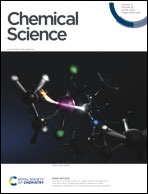[Ni30S16(PEt3)11]: an open-shell nickel sulfide nanocluster with a “metal-like” core†
Abstract
Reaction of [Ni(1,5-cod)2] (30 equiv.) with PEt3 (46 equiv.) and S8 (1.9 equiv.) in toluene, followed by heating at 115 °C for 16 h, results in the formation of the atomically precise nanocluster (APNC), [Ni30S16(PEt3)11] (1), in 14% isolated yield. Complex 1 represents the largest open-shell Ni APNC yet isolated. In the solid state, 1 features a compact “metal-like” core indicative of a high degree of Ni–Ni bonding. Additionally, SQUID magnetometry suggests that 1 possesses a manifold of closely-spaced electronic states near the HOMO–LUMO gap. In situ monitoring by ESI-MS and 31P{1H} NMR spectroscopy reveal that 1 forms via the intermediacy of smaller APNCs, including [Ni8S5(PEt3)7] and [Ni26S14(PEt3)10] (2). The latter APNC was also characterized by X-ray crystallography and features a nearly identical core structure to that found in 1. This work demonstrates that large APNCs with a high degree of metal–metal bonding are isolable for nickel, and not just the noble metals.
![Graphical abstract: [Ni30S16(PEt3)11]: an open-shell nickel sulfide nanocluster with a “metal-like” core](/en/Image/Get?imageInfo.ImageType=GA&imageInfo.ImageIdentifier.ManuscriptID=D2SC00960A&imageInfo.ImageIdentifier.Year=2022)
- This article is part of the themed collection: 2022 Chemical Science HOT Article Collection


 Please wait while we load your content...
Please wait while we load your content...